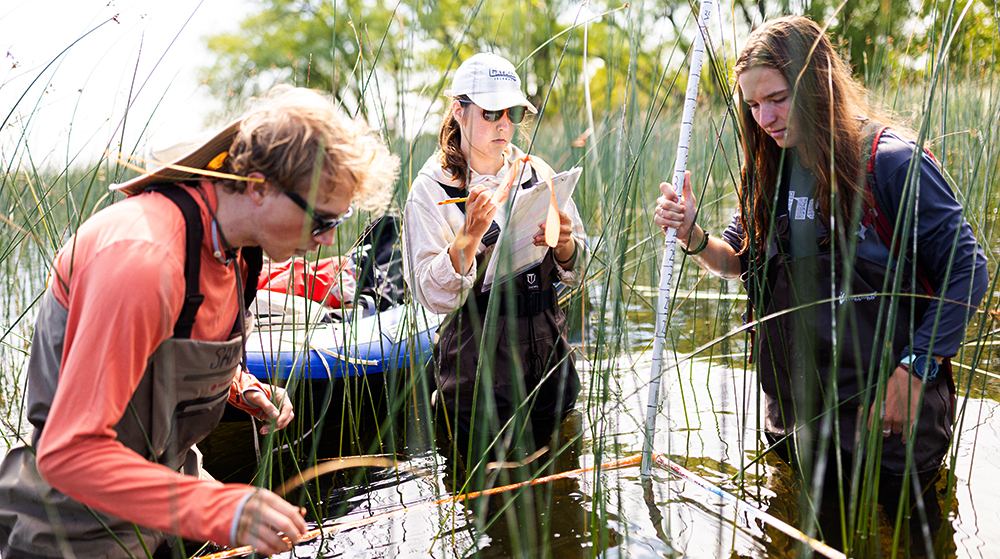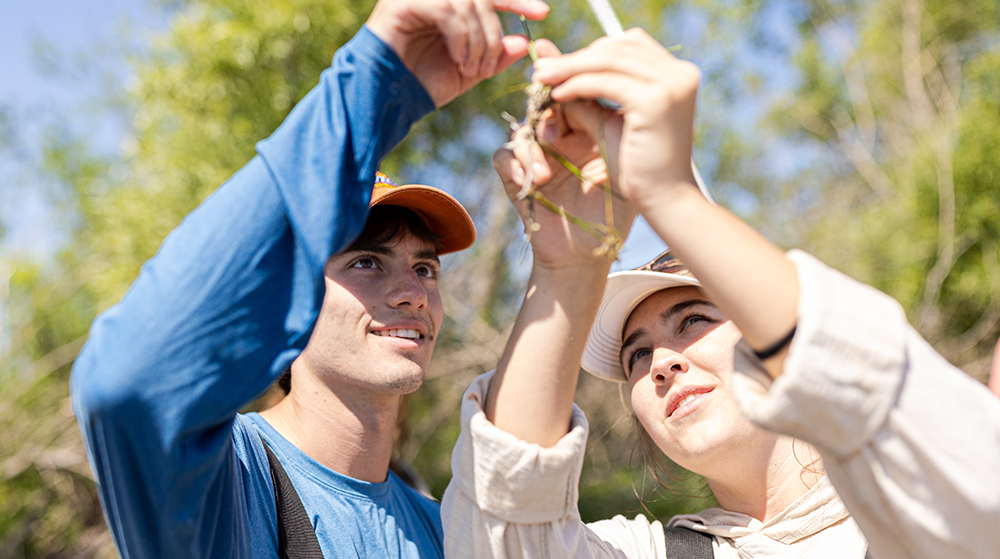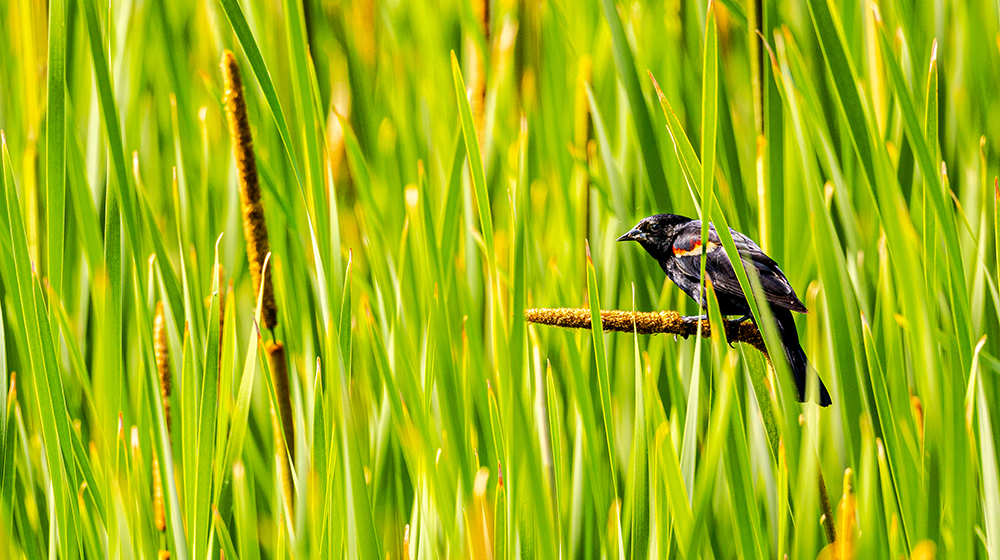Palmquist-Typha-research
Student Research Advances Ecological Restoration
At Loyola University Chicago's School of Environmental Sustainability, undergraduate students on Team Typha are preparing for meaningful careers in environmental science while contributing to vital ecological research.
Team Typha is a research group led by Assistant Professor Brian Ohsowski, PhD, and Research Associate Shane Lishawa, MS. The team's investigations focus on combatting invasive plants that disrupt wetland ecosystems, particularly the aggressive hybrid cattail known as Typha x glauca (Typha). The researchers aim to develop a scalable strategy to manage Typha invasions and restore biologically diverse wetlands in the Great Lakes region.

Madeline Palmquist (center) joined Team Typha during her sophomore year at Loyola. She studies how invasive cattails impact waterbirds.
Each summer, Ohsowski and Lishawa take a team of students to the University of Michigan Biological Research Station near the northern tip of Michigan's lower peninsula. While in Michigan, the students assist the faculty members with field research and work on independent projects related to the group's goals. When they return to campus in the fall, students help with lab work and data analysis and continue their individual, faculty-mentored projects.
Environmental science major Madeline Palmquist is a senior who joined Team Typha as a field technician during her sophomore year. In her junior year, she received funding through the Loyola Undergraduate Research Opportunities Program (LUROP) to support her research project, which complements Team Typha's broader studies.
Palmquist joined the team in Michigan during the summer of 2023. Her research there investigated how Typha invasions impact birds in Shiawassee National Wildlife Refuge, where Ohsowski and Lishawa lead a large-scale study on Typha management strategies.
"No one really knows the relationship between birds and Typha," said Palmquist. "We know that birds like to have some dense vegetation to hide in and also some open water. But we don't know how large-scale Typha invasion is impacting them." She noted that the U.S. Fish and Wildlife Service manages the Shiawassee site for bird habitat. "So studying birds in that area is going to be super helpful. We'll get a better understanding of how different restoration techniques impact the wildlife," she said.

Palmquist (right) examines a wetland plant with fellow Team Typha member Spencer Dzyacky, a junior in environmental science.
Palmquist installed microphones in three sections of the marsh to record bird sounds. She aimed to use the recordings to compare bird activity in each plot of marsh.
One study plot had a diverse assortment of well-established native plants, providing both cover and rich food sources for birds. Palmquist expected this section to attract the most birds and the greatest variety of species.
Typha had invaded the second plot, displacing many native plants. This plot offered birds dense vegetation for cover but fewer food-producing plants. The third plot was a Typha-invaded section of the marsh where Lishawa had harvested the invasive cattails—an experimental technique for combating Typha invasions and restoring biological diversity. Native plants had begun to rebound in the area, but the vegetation was still less dense than in the other two study sites.
Palmquist recorded bird calls in the three plots throughout the summer. Back on campus, she used software called Bird Net to analyze the recordings. The software produced a list of species recorded in each section of the marsh, indicating the diversity of birds in each area. It also produced counts of bird calls detected in each plot, indicating the overall levels of bird activity.
The analysis found 28 bird species in the site with rich native plant life, more than in the other two plots. The software detected bird calls 10,351 times in this plot, indicating far more activity than in the other two areas. The Typha-dominated plot had 24 species and 4,396 detections, while the site where the team had harvested Typha had 22 species and 2,529 detections.
The analysis confirmed Palmquist's hypothesis that the plot with diverse native plant life and thick vegetation would attract the greatest quantity and diversity of birds. She was intrigued to discover that the site managed for Typha had less bird activity and fewer species than the other two sites, with far less than the high-quality plot and somewhat less than the Typha-dominated plot. She noted that the managed plot where Lishawa had harvested the cattails had the shallowest water depth and the sparsest vegetation cover, which could explain the lower bird activity.

Red-winged blackbirds (pictured) were among the birds found in all three of section of marsh in Palmquist's study.
In addition to helping Palmquist compare the study plots, the Bird Net analysis turned up some exciting discoveries. Palmquist was thrilled that the Least Bittern, a small heron-like bird, was among the most frequently detected species in all three plots. These secretive marsh birds can be difficult to detect using traditional methods. The recordings also found Trumpeter Swans and Black Terns, a species in steep numerical decline.
"Overall, the results from this project are important for the future of bird population studies and new large-volume data collection methods. The raw, unfiltered data had over one million data points of species detected, said Palmquist. "Being able to detect such a high quantity of secretive marsh birds on a large temporal and spatial scale is incredibly exciting."
Palmquist will complete her bachelor's degree in environmental science in May 2024. After graduation, she will stay at Loyola for two more years to pursue a master's degree in environmental science and sustainability. As a graduate student, she will continue to work with Team Typha, building on her investigations into Typha's impacts on waterbird populations.
For her graduate research, Palmquist plans to revisit the study sites to see how bird activity changes in the Typha-dominated plot, where the research team plans to harvest patches of the cattails to create open space for potential waterbird use. She will study additional managed and Typha-dominated sites to investigate how waterbird usage changes over time. Her work will provide a greater understanding of how Typha management strategies impact birds, helping to guide future practices for the benefit of wildlife.
After completing her education, Palmquist plans to build a career researching and protecting wetlands with organizations such as the U.S. Fish and Wildlife Service or the Nature Conservancy. She said her time with Team Typha has helped shape her plans.
"I really enjoy fieldwork and experimental restoration. Going out and doing restoration and then seeing the impact is really cool to me," she said. "This experience has definitely changed how I'm thinking about science in general but also the kind of science I want to do later. Whatever my job, I hope to spend most of my days out in the field enjoying beautiful wetlands and learning more about their complexities."
Palmquist looks forward to beginning her next adventures as a graduate student. She is confident that the education and mentorship she receives in SES and as a member of Team Typha will prepare her to become a successful independent researcher contributing to the conservation of vital wetland habitats.
-- Story by Stephanie Folk
-- Photos by Lukas Keapproth
Each summer, Ohsowski and Lishawa take a team of students to the University of Michigan Biological Research Station near the northern tip of Michigan's lower peninsula. While in Michigan, the students assist the faculty members with field research and work on independent projects related to the group's goals. When they return to campus in the fall, students help with lab work and data analysis and continue their individual, faculty-mentored projects.
Environmental science major Madeline Palmquist is a senior who joined Team Typha as a field technician during her sophomore year. In her junior year, she received funding through the Loyola Undergraduate Research Opportunities Program (LUROP) to support her research project, which complements Team Typha's broader studies.
Palmquist joined the team in Michigan during the summer of 2023. Her research there investigated how Typha invasions impact birds in Shiawassee National Wildlife Refuge, where Ohsowski and Lishawa lead a large-scale study on Typha management strategies.
"No one really knows the relationship between birds and Typha," said Palmquist. "We know that birds like to have some dense vegetation to hide in and also some open water. But we don't know how large-scale Typha invasion is impacting them." She noted that the U.S. Fish and Wildlife Service manages the Shiawassee site for bird habitat. "So studying birds in that area is going to be super helpful. We'll get a better understanding of how different restoration techniques impact the wildlife," she said.
Palmquist installed microphones in three sections of the marsh to record bird sounds. She aimed to use the recordings to compare bird activity in each plot of marsh.
One study plot had a diverse assortment of well-established native plants, providing both cover and rich food sources for birds. Palmquist expected this section to attract the most birds and the greatest variety of species.
Typha had invaded the second plot, displacing many native plants. This plot offered birds dense vegetation for cover but fewer food-producing plants. The third plot was a Typha-invaded section of the marsh where Lishawa had harvested the invasive cattails—an experimental technique for combating Typha invasions and restoring biological diversity. Native plants had begun to rebound in the area, but the vegetation was still less dense than in the other two study sites.
Palmquist recorded bird calls in the three plots throughout the summer. Back on campus, she used software called Bird Net to analyze the recordings. The software produced a list of species recorded in each section of the marsh, indicating the diversity of birds in each area. It also produced counts of bird calls detected in each plot, indicating the overall levels of bird activity.
The analysis found 28 bird species in the site with rich native plant life, more than in the other two plots. The software detected bird calls 10,351 times in this plot, indicating far more activity than in the other two areas. The Typha-dominated plot had 24 species and 4,396 detections, while the site where the team had harvested Typha had 22 species and 2,529 detections.
The analysis confirmed Palmquist's hypothesis that the plot with diverse native plant life and thick vegetation would attract the greatest quantity and diversity of birds. She was intrigued to discover that the site managed for Typha had less bird activity and fewer species than the other two sites, with far less than the high-quality plot and somewhat less than the Typha-dominated plot. She noted that the managed plot where Lishawa had harvested the cattails had the shallowest water depth and the sparsest vegetation cover, which could explain the lower bird activity.
In addition to helping Palmquist compare the study plots, the Bird Net analysis turned up some exciting discoveries. Palmquist was thrilled that the Least Bittern, a small heron-like bird, was among the most frequently detected species in all three plots. These secretive marsh birds can be difficult to detect using traditional methods. The recordings also found Trumpeter Swans and Black Terns, a species in steep numerical decline.
"Overall, the results from this project are important for the future of bird population studies and new large-volume data collection methods. The raw, unfiltered data had over one million data points of species detected, said Palmquist. "Being able to detect such a high quantity of secretive marsh birds on a large temporal and spatial scale is incredibly exciting."
Palmquist will complete her bachelor's degree in environmental science in May 2024. After graduation, she will stay at Loyola for two more years to pursue a master's degree in environmental science and sustainability. As a graduate student, she will continue to work with Team Typha, building on her investigations into Typha's impacts on waterbird populations.
For her graduate research, Palmquist plans to revisit the study sites to see how bird activity changes in the Typha-dominated plot, where the research team plans to harvest patches of the cattails to create open space for potential waterbird use. She will study additional managed and Typha-dominated sites to investigate how waterbird usage changes over time. Her work will provide a greater understanding of how Typha management strategies impact birds, helping to guide future practices for the benefit of wildlife.
After completing her education, Palmquist plans to build a career researching and protecting wetlands with organizations such as the U.S. Fish and Wildlife Service or the Nature Conservancy. She said her time with Team Typha has helped shape her plans.
"I really enjoy fieldwork and experimental restoration. Going out and doing restoration and then seeing the impact is really cool to me," she said. "This experience has definitely changed how I'm thinking about science in general but also the kind of science I want to do later. Whatever my job, I hope to spend most of my days out in the field enjoying beautiful wetlands and learning more about their complexities."
Palmquist looks forward to beginning her next adventures as a graduate student. She is confident that the education and mentorship she receives in SES and as a member of Team Typha will prepare her to become a successful independent researcher contributing to the conservation of vital wetland habitats.
-- Story by Stephanie Folk
-- Photos by Lukas Keapproth
